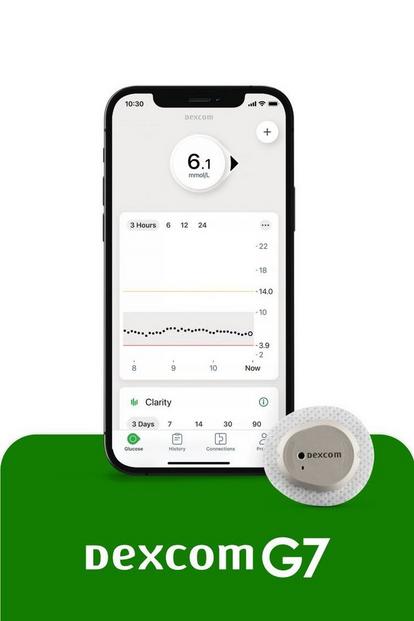
The power to manage your diabetes with confidence
Make better decisions in the moment without finger pricks*
*Finger pricks required for diabetes treatment decisions if symptoms or expectations do not match readings.

Try a free Dexcom ONE+ sample now
Request a free 10-day sensor and experience everything it has to offer for yourself.
Dexcom is available on the NHS
In England and Wales, NICE (The National Institute for Health and Care Excellence)* has guidelines on funding CGM for some people with diabetes.
- Adults and children with type 1 diabetes should be offered a choice of CGM. 1,2 Read the full NICE guidance here.
- For people with insulin-treated type 2 diabetes, a CGM can be considered, based on certain criteria.3Read the full NICE guidance here
In Scotland, SIGN (Scottish Intercollegiate Guideline Network) has guidelines on access to people with type 1 diabetes that covers.4
- Eligibility for CGM and hybrid closed loop systems
- Factors to support the choice of CGM
- Offering CGM to all children and young people with type 1 diabetes, alongside education and support for their families and carers
Read the full SIGN guidance here

Type 1 Diabetes
Find out how Dexcom can help you better manage your type 1 diabetes and learn more about connected insulin delivery.

Type 2 Diabetes
Discover how Dexcom can give you confidence to better manage your type 2 diabetes.
Hear what our warriors have to say
Jim uses multiple daily insulin injections to manage his type 2 diabetes and receives Dexcom ONE+ on the NHS.
Jim, Dexcom Warrior
Jharna lives with type 1 diabetes and uses Dexcom G7. She loves the flexibility it offers, particular the direct to watch feature so she doesn’t always need her phone with her.
Jharna, Dexcom Warrior


References:
*© NICE [2024]. All rights reserved. Subject to Notice of rights. NICE guidance is prepared for the National Health Service in England. All NICE guidance is subject to regular review and may be updated or withdrawn. NICE accepts no responsibility for the use of its content in this product/publication.
†If you have diabetes, you can claim VAT relief.
1. NICE Guideline NG17. NICE, Type 1 diabetes in adults: diagnosis and management, Accessed October 2024. https://www.nice.org.uk/guidance/ng17.
2. NICE Guideline NG18. NICE, Type 1 and Type 2 diabetes in children and young people: diagnosis and management. Accessed October 2024. https://www.nice.org.uk/guidance/ng18.
3. NICE Guideline NG28. NICE, Type 2 diabetes in adults: management, Accessed October 2024. https://www.nice.org.uk/guidance/ng28.
4. SIGN Guidelines 170. SIGN, Type 1 diabetes in adults and children: optimising glycaemic control, Accessed October 2024. https://www.sign.ac.uk/our-guidelines/optimising-glycaemic-control-in-people-with-type-1-diabetes/
*© NICE [2024]. All rights reserved. Subject to Notice of rights. NICE guidance is prepared for the National Health Service in England. All NICE guidance is subject to regular review and may be updated or withdrawn. NICE accepts no responsibility for the use of its content in this product/publication.
†If you have diabetes, you can claim VAT relief.
1. NICE Guideline NG17. NICE, Type 1 diabetes in adults: diagnosis and management, Accessed October 2024. https://www.nice.org.uk/guidance/ng17.
2. NICE Guideline NG18. NICE, Type 1 and Type 2 diabetes in children and young people: diagnosis and management. Accessed October 2024. https://www.nice.org.uk/guidance/ng18.
3. NICE Guideline NG28. NICE, Type 2 diabetes in adults: management, Accessed October 2024. https://www.nice.org.uk/guidance/ng28.
4. SIGN Guidelines 170. SIGN, Type 1 diabetes in adults and children: optimising glycaemic control, Accessed October 2024. https://www.sign.ac.uk/our-guidelines/optimising-glycaemic-control-in-people-with-type-1-diabetes/

